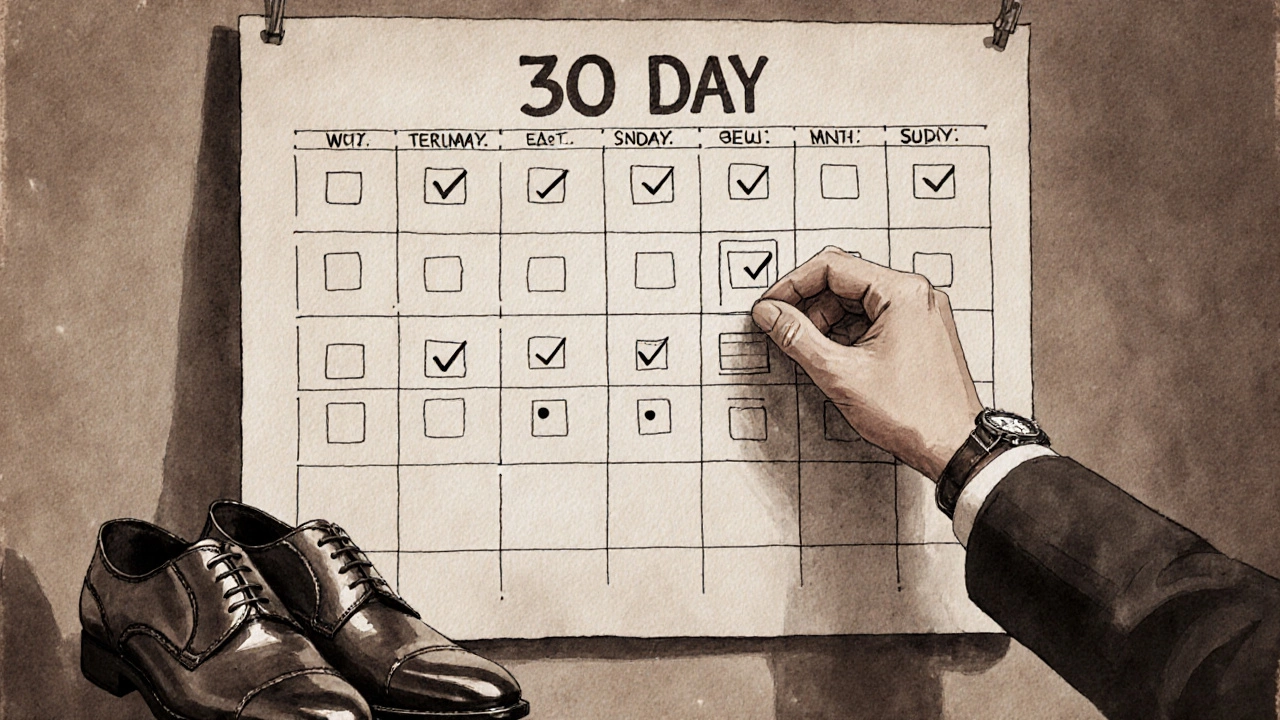Habit Tracker & Mindset Builder
Build Your Transformation Plan
Track your daily habits and mindset shifts to transform your life over 30 days
Add Your Habit
Your Progress Dashboard
When you ask, mindset is a set of mental attitudes and beliefs that shape how you interpret experiences and make decisions, you’re really asking about the foundation of change. A refined gentleman knows that lasting transformation starts not with a wardrobe overhaul, but with the way his mind approaches each day. Below is a pragmatic roadmap that blends timeless principles with modern psychological insight, all aimed at helping you reshape your life with confidence and composure.
Understanding the Power of Mindset
Before any action, you must recognise the engine driving your behavior. Personal Development is the intentional effort to improve one’s character, skills, and overall quality of life hinges on mindset. Two dominant patterns emerge:
- Fixed mindset: the belief that abilities are static.
- Growth mindset: the conviction that qualities can be cultivated through effort.
Research from Stanford psychologist Carol Dweck shows that individuals who adopt a growth mindset achieve higher performance across careers, sport, and relationships. For a gentleman, this isn’t an abstract theory-it’s the difference between fearing failure and viewing setbacks as opportunities to refine one’s craft.
Identify Your Current Drivers
Clarity begins with honest self‑audit. Grab a notebook, a fountain pen, and answer these questions:
- What daily habits give me energy, and which drain it?
- Which beliefs keep me stuck? (e.g., “I’m not charismatic enough.”)
- What outcomes am I truly seeking-status, comfort, purpose?
Write the answers without judgment. This exercise surfaces the prevailing Mental Resilience the capacity to recover quickly from difficulties and maintain psychological equilibrium level you’re operating at. Recognising the baseline allows you to chart a realistic ascent.
Adopt a Growth Mindset
Transitioning from fixed to growth isn’t a flip‑switch; it’s a series of mental rehearsals. Here are five practical steps:
- Re‑label challenges: When a project feels daunting, call it a "learning experiment" instead of a "risk."
- Embrace effort: Treat consistent practice as a mark of professionalism, not a sign of inadequacy.
- Seek feedback: Ask trusted colleagues or a mentor for concrete observations, and act on them promptly.
- Celebrate process: Note improvements in technique, not just final results.
- Model curiosity: Allocate weekly reading time-be it classic literature or modern leadership essays.
These habits reinforce the neural pathways associated with a growth mindset, gradually rewiring your default response to obstacles.

Build Mental Resilience
Resilience works hand‑in‑hand with mindset. To fortify it, integrate the following routines:
- Morning breathwork: Five minutes of controlled breathing stabilises the nervous system.
- Physical conditioning: Regular weight training or rowing cultivates discipline and stress tolerance.
- Journaling setbacks: Document what went wrong, what you learned, and the next action.
When practiced consistently, these actions create a buffer against anxiety and help you maintain poise during high‑stakes negotiations or social engagements.
Design Effective Habits
Habit formation is a science. Habit Formation refers to the process by which new behaviours become automatic through repeated execution follows a cue‑routine‑reward loop. To engineer new habits that serve your life redesign:
- Start small: Replace a 5‑minute evening scroll with a brief review of tomorrow’s agenda.
- Anchor to existing routine: Tie the new habit to a well‑established one, like reading a news brief after your morning coffee.
- Make it attractive: Pair the habit with something enjoyable-listen to a favorite jazz record while polishing shoes.
- Track progress: Use a simple habit‑tracker grid; visual streaks reinforce commitment.
Within 21-30 days, the behavior shifts from effortful to instinctive, freeing mental bandwidth for higher‑order pursuits.
Align Actions with Core Values
A life that feels authentic rests on values alignment. Identify three core values-perhaps Purpose the enduring sense of direction that guides decisions and actions, integrity, and continuous learning. Then audit weekly activities against these pillars. If a networking event feels superficial, politely decline and redirect energy toward a mentorship program that better reflects your purpose.

Create Accountability Structures
No gentleman is an island. An Accountability Partner is a trusted individual who monitors progress, offers honest feedback, and reinforces commitments can dramatically accelerate change. Choose someone whose standards you respect-perhaps a senior colleague or a long‑standing friend. Set a bi‑weekly check‑in, share specific goals, and celebrate milestones together.
Putting It All Together: A 30‑Day Blueprint
Combine the elements above into a coherent plan. Below is a concise calendar you can print and hang in your study.
| Day | Focus Area | Key Action |
|---|---|---|
| 1‑3 | Self‑Audit | Complete the "Identify Your Current Drivers" questionnaire. |
| 4‑7 | Mindset Shift | Replace fixed‑mindset statements with growth‑oriented affirmations; begin daily journaling. |
| 8‑14 | Resilience Routines | Add morning breathwork and three strength‑training sessions. |
| 15‑21 | Habit Engineering | Implement two new micro‑habits using cue‑routine‑reward loops. |
| 22‑26 | Values Alignment | Review weekly calendar; eliminate activities misaligned with core values. |
| 27‑30 | Accountability | Hold first formal check‑in with your accountability partner; set next month’s goals. |
At the end of the month, assess progress against your original audit. Notice which beliefs have softened, which habits have stuck, and how your overall composure has improved. Use those insights to refine the next iteration.
Frequently Asked Questions
Can a mindset really change my career trajectory?
Absolutely. When you view challenges as learning opportunities, you’re more likely to take calculated risks, seek mentorship, and persist through setbacks-all traits that accelerate professional advancement.
How long does it take to see measurable improvement?
The first noticeable shift often appears within 2-4 weeks as new habits become automatic. Deeper cognitive changes, such as a sustained growth mindset, typically solidify after 60‑90 days of consistent practice.
What if I slip back into a fixed mindset?
Slip‑ups are inevitable. The key is to notice the moment, re‑label the thought, and apply the growth‑oriented counter‑statement. Over time, the frequency of relapses diminishes.
Do I need a coach or can I do this solo?
Self‑directed work is possible, but an external perspective-whether from a mentor, coach, or accountability partner-provides faster feedback and keeps you honest.
How do I maintain progress after the 30‑day plan?
Treat the 30‑day blueprint as a prototype. At the end of each cycle, revise your values, set new micro‑goals, and schedule the next accountability check‑in. Continuous iteration sustains momentum.

